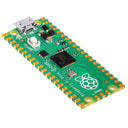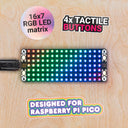Raspberry Pi Pico
by Raspberry Pi








A low cost, high-performance microcontroller board built around Raspberry Pi's very own chip - the RP2040.
Raspberry Pi Pico is Raspberry Pi's first microcontroller board, designed especially for physical computing. Microcontrollers are a different type of device than Single Board Computers (like the Raspberry Pi 4 and previous generations of Pi), they don't run an operating system and they are typically programmed to do just one task - though that task can be pretty intricate and exciting! They're perfect for experimenting with hardware and using as the brains of custom devices, machines and inventions.
It can be easily reprogrammed over USB from a Raspberry Pi or other computer using the C/C++ SDK or the official MicroPython port. The landing page is the best place to get started, or scroll down for links to the technical documentation for both the Raspberry Pi Pico microcontroller board and the RP2040 microcontroller chip.
Raspberry Pi Pico comes without header pins so you'll need to pick some up separately if you're planning on plugging your Pico into into a breadboard or one of our Raspberry Pi Pico add-ons. Alternatively you can buy an official Raspberry Pi Pico H, which comes with pre-soldered pin headers and a pre-soldered debug connector (3 pin JST-SH)
Board Specifications
Raspberry Pi Pico is a low-cost, high-performance microcontroller board with flexible digital interfaces, built on silicon designed at Raspberry Pi. Key features include:
- RP2040 microcontroller chip designed by Raspberry Pi in the United Kingdom
- Dual-core ARM Cortex M0+ processor, flexible clock running up to 133 MHz
- 264kB of SRAM, and 2MB of on-board Flash memory
- Castellated module allows soldering direct to carrier boards
- USB 1.1 Host and Device support
- Low-power sleep and dormant modes
- Drag & drop programming using mass storage over USB
- 26 multi-function GPIO pins
- 2×SPI, 2×I2C, 2×UART, 3×12-bit ADC, 16×controllable PWM channels
- Accurate clock and timer on-chip
- Temperature sensor
- Accelerated floating point libraries on-chip
- 8×Programmable IO (PIO) state machines for custom peripheral support
Documentation
Documentation for the Raspberry Pi Pico board and the RP2040 microcontroller:
- Raspberry Pi Pico Datasheet - An RP2040-based microcontroller board
- RP2040 Datasheet - A microcontroller by Raspberry Pi
- Hardware design with the RP2040 - Using the RP2040 microcontroller to build boards and products
- Getting Started with Raspberry Pi Pico - C/C++ development with the Pico and other RP2040-based microcontroller boards
- Pico C/C++ SDK - Libraries and tools for C/C++ development on the RP2040 microcontroller
- Pico Python SDK - A MicroPython environment for the RP2040 microcontroller
The API level Doxygen documentation for the Raspberry Pi Pico C/C++ SDK is available as a micro-site.
Pinout
There's a handy interactive pinout for Raspberry Pi Pico at pico.pinout.xyz.
-
Without Headers
SC0915Out of stock£3.17 -
With Headers
SC0917Out of stock£4.00
Add extra functionality to your Pico with a pack
-
 Pico Unicorn Pack+ £18.25
Pico Unicorn Pack+ £18.25 -
 Pico Scroll Pack+ £11.25
Pico Scroll Pack+ £11.25 -
 Pico Display Pack+ £12.50
Pico Display Pack+ £12.50
Turn your Pico into something else with a base
-
 Pico Breakout Garden Base+ £11.00
Pico Breakout Garden Base+ £11.00 -
 Pico RGB Keypad Base+ £18.25
Pico RGB Keypad Base+ £18.25 -
 Pimoroni Pico VGA Demo Base+ £16.50
Pimoroni Pico VGA Demo Base+ £16.50
Extenders, headers, cables, and more
-
 Pico Proto+ £1.75
Pico Proto+ £1.75 -
 Pico Decker (Quad Expander)+ £11.00
Pico Decker (Quad Expander)+ £11.00 -
 Pico Omnibus (Dual Expander)+ £7.00
Pico Omnibus (Dual Expander)+ £7.00 -
 LiPo SHIM for Pico+ £6.25
LiPo SHIM for Pico+ £6.25 -
 Pico Header Pack+ £1.50
Pico Header Pack+ £1.50 -
USB A to microB cable - Black – 50cm+ £2.50
Kits and activities
Shop with confidence – we've been serving the hobbyist electronics, Maker, and retro gaming communities since 2012.
- Satisfaction or refund guarantee
- Worldwide shipping via mail or courier
- 57,000+ customer reviews
- Approved Raspberry Pi Reseller
- Secure website and payments











